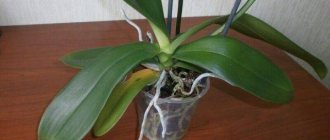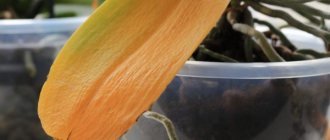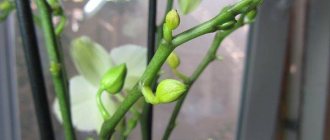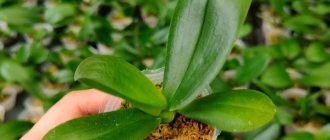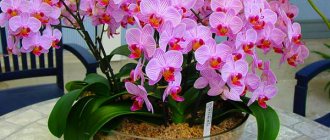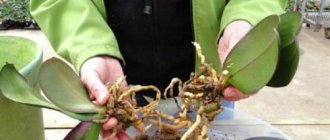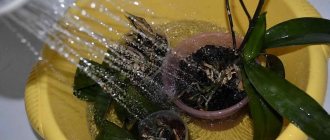What to do if an orchid has leaves on its peduncle? Birth of a baby
After the end of flowering, a lonely flower-bearing arrow remains in the flowerpot. If it remains alive and green, without signs of drying out, then after a while dormant buds may wake up , from which the following can form:
- lateral peduncle , thanks to which the orchid will bloom again;
- small leaves that will eventually develop roots. the children (shoots) that develop - small, cavity-formed orchids.
Often they appear not only on the flower stalk, but also grow from the roots (basal children) or from buds in the leaf axils.
On the peduncle
The formation of children on the flower stalk means that even an inexperienced amateur can grow one or several independent plants without extra effort, without injuring the orchid.
This method is most convenient for vegetative propagation of orchids at home.
Baby on a peduncle.
Conditions for appearance
The most suitable period for the formation of children comes after the end of a long flowering period. The plant must have a well-developed root system and at least two pairs of large leaves.
As a rule, there are 3-4, sometimes more, dormant buds on the peduncle. In order for them to wake up, it is necessary to cut off the peduncle above one of them at a height of 2-3 cm.
Trimming the peduncles does not guarantee that the buds will wake up; after pruning, the peduncle can remain dormant for a whole year and then dry up. More often, pruning stimulates the awakening of the remaining dormant buds that are located on the flower-bearing arrow.
Sometimes children form on their own, but in some cases, even if the plant is in optimal conditions, stimulation of their forcing is necessary . This is facilitated by:
- daily temperature fluctuations. At night it should be cool - up to +17-18℃, during the day - up to +27-30℃. These conditions are most favorable in the spring and summer on a glazed balcony;
- poor watering should be combined with high relative humidity. When kept indoors, this requires regular spraying and placing the plant on a tray with damp moss or pebbles;
- a large amount of intense diffuse light.
The probability of the formation of children on flower-bearing arrows greatly increases with the use of special preparations - growth stimulants, primarily cytokinin paste.
When can you separate?
At the first stage, it is quite difficult to distinguish the baby from the side arrow on the peduncle, but as it grows, the differences will become more and more noticeable:
- The baby's leaves appear first, then the roots develop;
- 6 months after the baby appears, she already has 2 pairs of leaves.
After six months, the formed process is ready for separation. By this time, the baby should have formed 3-4 roots about 5 cm long. If the baby’s roots are too small, then the transplanted orchid will take a long time to take root and hurt. In this case, you should postpone the separation and wait for the roots to grow.
The baby can be separated when it has formed roots.
Separation technology. How to eliminate the main risks for the plant?
In order to eliminate possible risks for an adult plant, first of all, prepare the tools and related materials for work:
- disinfect garden pruners, knife or scissors;
- crush several tablets of activated carbon;
- prepare a transparent glass or flowerpot with drainage holes;
- purchase or prepare your own substrate for planting a small orchid.
The volume of the glass must correspond to the volume of the root system : the roots in it must be placed quite tightly.
Separating the baby from the flower-bearing arrow is quite simple:
- when separating at the edges, the children leave up to 2 cm of the stem of the flower-bearing arrow;
- the cut is sprinkled with crushed activated carbon and allowed to dry for half an hour;
- the baby is transplanted into a separate pot with a special soil mixture and placed in a greenhouse.
After nine months, the small orchid no longer needs greenhouse conditions, and the first flowering can be expected in 2-3 years.
In the leaf axil
From the buds, which are located in the axils of the leaves, peduncles develop in some climatic conditions, and lateral shoots (babies) in others . Sometimes the plant produces several shoots at once.
A baby growing from the axil of a leaf.
During the period of formation of shoots, the orchid requires ordinary care and regular watering. At this time, fertilizing is carried out with fertilizers containing a high nitrogen content, which stimulates the growth of the baby.
How long can a mother plant grow?
In order for the baby to be fully formed, it must spend about six months . Its maturity is determined by the number and length of roots.
We continue the luxurious flowering
The long flowering of your beauty has ended, and you are looking at the orchid in confusion, deciding what to do? Don’t rush to grab the scissors and remove the peduncle, because it can still please you with beautiful flowers.
Carefully examine all the side branches and the tip of the arrow itself; if they are green, and tiny green tips are visible, then it is likely that the plant will soon continue to bloom. Sometimes it occurs just a few weeks after the main one, but it can take about six months.
If the top of the peduncle has dried up, but the main part is green, then there is a high probability that it will still serve you. To do this, use a little trick - cut off all the dry part, leaving healthy tissue. The flower stalks of orchids most often have several buds that are dormant. If you show a little patience, you will certainly wait for the appearance of new buds or even the long-awaited baby baby!
You can help the orchid regain its strength and speed up its flowering. It will take a little from you - make sure that the bush does not dry out, otherwise it will direct all its energy into the roots and leaves. Be sure to apply nutrient solutions, even by foliar application.
If your beauty is stubborn, you can shock her a little. How to do this without harm to the orchid? I advise you to do this - water the bush thoroughly and hide it for a week or a week and a half in a dark place. Once you return it to a bright windowsill, flowering will not take long, your pet will be so happy.
Are you afraid that the bush will not tolerate a long absence of light? Try another method - leave it on the window, but completely stop watering. Usually a half-moon is enough for the orchid to stop being stubborn, understand what is required of it, and continue flowering.
If your pet is standing in the most comfortable place, and you strictly follow all the rules for caring for it, then usually no other influence will be required - the arrow will release new buds quite quickly. It is important to immediately stop adding nutrient solutions - unlike most plants, fertilizing will only do harm - the buds will begin to fade quite quickly.
Reasons for the appearance of babies on the stem
Experienced flower growers believe that the formation of babies on the trunk or in the leaf axil is associated with unfavorable growing conditions:
- stem injury;
- dying off of the growth point;
- long-term drought;
- with the development of a flower-bearing arrow from the center of the rosette.
Dying of the growing point
Typically, stem babies appear when the growing point dies or after a peduncle has developed from it. Such a plant will no longer grow or bloom . The baby that has formed at the growth point will give rise to a new plant.
Key Features
If the babies appear on the stem itself, it is not recommended to separate them , since they do not form their own roots and if separated incorrectly, the mother plant may die.
Leaves have appeared on the orchid's shoot, what to do?
Phalaenopsis are often called "butterfly orchids" because their charming flowers come in a variety of shapes, sizes, patterns and colors - white, yellow, pink, red, purple, brown and green - reminiscent of tropical moths. The elegant lip of the flower, often contrasting in color, stands out effectively against the background of patterned (striped, netted, tiger, speckled) or evenly colored flower petals, reaching 8 cm in diameter. There are two types of phalaenopsis: standard and miniature. During flowering, standard phalaenopsis species reach a height of 1 meter with a dozen or more flowers on a long peduncle; miniature, no more than 30 cm high, with fewer smaller flowers on a short peduncle. Different types and varieties of phalaenopsis bloom at different times, each orchid can bloom up to 3 times a year. The tongue-shaped, wide leaves of phalaenopsis (usually 4-5 of them) appear in pairs on the rhizome growing upward. The flower arrow appears at the base of the last formed leaf. The falling of the lower old leaves is normal, so the orchid does not grow too much. There are no pseudobulbs in phalaenopsis, but there are a huge number of roots with which in nature these orchids firmly hold onto the bark of trees or rocks (among phalaenopsis there are both epiphytes and lithophytes). Phalaenopsis are unpretentious evergreen, ever-growing orchids; Their species and hybrids that bloom almost all year round are ideal for beginners. With proper care, phalaenopsis bloom profusely, for a long time and live in the house for up to 7 years. Phalaenopsis requires a warm place with diffused light without direct sunlight. Phalaenopsis also grow well in the back of the room with sufficient artificial lighting. With a lack of light and when the temperature drops below 16 degrees, the buds of phalaenopsis prepared for flowering may fall off. The temperature of keeping these heat-loving orchids should not be lower than 18 degrees (except in autumn, when it is necessary to keep phalaenopsis for about 1-2 months at a temperature of 16 degrees for the formation of flower buds); The comfort zone for phalaenopsis is within 22-24 degrees. Watering should be very moderate all year round, especially in winter. The substrate should not dry out too much, but before the next watering, let it dry slightly - the roots of phalaenopsis, in addition to water, need air. Excessive watering may cause fungal infections. Irrigation water should not get into the growth point - the center of the rhizome in order to avoid its rotting. You can water phalaenopsis using the “bathing” method, half-immersing the pot with the orchid for a short time in a bucket of soft water so that the substrate is saturated with moisture. Phalaenopsis requires constant maintenance of high air humidity in all possible ways. Spraying the leaves and air around the orchid should be carried out in the finest spray mode, so that the water comes out in the form of “fog” and falls on the leaves in the form of “water dust”, and not droplets, which, when flowing, can fall into the core of the rosette of leaves, which will lead to to rotting. When spraying, water should not get on the flowers. In dry air, the orchid can be affected by scale insects. Phalaenopsis is transplanted once every 2 years into a rough, loose orchid substrate; The pot is taken a little larger than before. When replanting, you need to minimize damage to the fragile roots in contact with the edges of the pot; The pot is taken a little larger than before. In the summer, 2 times a month, orchids need to be fertilized in a low concentration (sick plants cannot be fertilized); during the rest of the year, including winter, they are rarely fertilized in an even lower concentration. Phalaenopsis do not form pseudobulbs and reproduce by “babies” appearing on flower stems; When the roots of young shoots reach a length of 5 cm, they can be planted in a separate pot. Phalaenopsis flower shoots are beautifully curved or drooping (and on one flower shoot an orchid can bloom 2-3 times if you cut the flower stem above the 3rd or 4th node until it has completely bloomed). Shortening the stem helps
How to make an orchid bloom at home
There are 2 ways to make an orchid bloom and now we will talk about how to stimulate it so that your beauty will give you beautiful flowers. What are these ways by which you can make an orchid bloom?
- Sudden change in temperature
- Lack of water (drought).
Important! Not all orchids can be stimulated to bloom. Stimulation can only be carried out on adults who have rested after the last flowering of orchids.
As you understand, you should not force the orchid to bloom again after a short period of time.
And under no circumstances conduct such experiments with weakened, young, or recently flowered plants.
How to make an orchid bloom at home method No. 1
Temperature change stimulation
This method can be used on almost all types of epiphytic orchids. This method can be carried out in the spring, when the night temperature reaches 16C. From now on, you can take your beauty to an unglazed balcony or street. If your balcony is glazed, then place the orchid closer to the window.
During the day, bring the orchid into the house. Of course, if you don’t have direct sunlight on your balcony, or you can shade the orchid, then you can leave it outside day and night.
At night the plant will cool down, and during the day it will warm up accordingly. As a result, the orchid will receive quite a lot of carbon dioxide, which is more than enough for leaf growth and flowering.
Just 7-14 such nights and your beauty will soon bloom. This method can be carried out not only in spring, but also in early summer and autumn. But unlike spring nights, summer nights are warmer and, therefore, more procedures need to be carried out.
As for autumn, the temperature during this period is suitable both day and night, but, unfortunately, daylight hours are shortened. Therefore, spring is the most favorable time to stimulate an orchid to bloom.
This method leads to 100% results and does not have a negative effect on your beauty. However, you should not count on long-term flowering, especially if during the rest of the time you did not pay due attention to the orchid and did not care for it well.
Method No. 2 stimulation by drought
This method is most suitable for orchids that do not need a period of rest: phalaenopsis, vanda, etc. This method allows you to make an orchid bloom at any time of the year, even if there are no strong temperature changes. But it cannot be used if the air temperature is more than 30C.
Even if you don’t have enough light in your room, you can still awaken dormant flower buds using this method. In about a month (after a maximum of 2 months, even the most capricious orchid begins to bloom).
An orchid lays flower buds several times a year, but they awaken only under favorable conditions.
This method involves sharply reducing watering. If earlier you watered your beauty as the substrate dried, now you don’t need to do this as soon as the soil dries. If the weather is too hot, then the orchid is not watered for another 3-4 days; in cooler times, the interval is increased to 7 days.
If you are afraid of getting lost and calculating incorrectly when to water the plant, then you can do it easier by doubling the interval between waterings. For example, you used to water your orchids after 4 days, now start watering them after 8 days.
Try not to spare the plant, do not even spray it at this time. It is important to create strict conditions. Also exclude all supplements, biostimulants and do not give her a hot shower. When you see the appearance of a peduncle, you can return to the normal watering regime. It is not necessary to fertilize the plant at this time.
If your plant blooms in autumn or winter, then at this time there is not enough light for it, so you will have to add additional light to the plant. It is not necessary to illuminate the entire plant; it is enough if the light hits the top of the flower. It is also important not to allow the lamp to heat the flower.
If the orchid does not have enough light in the autumn-winter period, the peduncle can stop its development at any time.
How to make orchids bloom - video:
In tropical latitudes there grows a flower of equal beauty that is difficult to find. Its name is as unusual and exotic as its appearance - orchid.
Many flower growers want to admire this unusual creation not in the tropics, but at home, so they ask the question - how to make this capricious beauty bloom while in a harsh climate?
Add a comment Cancel reply
You must be logged in to post a comment.
How is it different from other parts of the plant?
Often, novice flower growers cannot determine what the orchid has produced: a root or an arrow . Indeed, only a florist with many years of experience can accurately identify the part of a plant, especially at first. But after some time, when the process reaches 1 cm in length, this will not be difficult to do.
Immediately after its appearance, the root begins to look down (stretches towards the soil and nutrients in it), and the arrow begins to look up (stretches towards the light), just like the root baby. The root is smooth, and the arrow contains "scales". The root most often grows from the neck of the plant trunk, the shoot - between the leaf plates.
We invite you to watch a video on how to distinguish the peduncle from other parts of the orchid:
Role” in the life of a plant
The arrow of an orchid performs a reproductive function. It most often produces babies - small copies of the orchid itself. After they produce a couple of leaves and 3-4 roots, they can be rooted.
In addition, the peduncle is involved in the appearance and development of flowers and buds , nourishes them with water and nutrients, thereby continuing to perform a reproductive function. Each orchid flower contains a seed capsule in which the seeds ripen after pollination by insects. An orchid can also be grown from seeds, but this can happen either in a natural environment - the tropics, or in laboratories, since this process is long and intricate.
How did the flower shoot?
After the period of active growth of roots and leaves, the orchid enters a resting phase, during which the plant shoots out an arrow. Most often this period occurs in autumn, but in good conditions the orchid can bloom several times a year.
An orchid shoot is released from the axil of a leaf , usually the lowest one. The leaf axil is the place where the orchid leaf comes into contact with its trunk. The arrow breaks through the sheet and tends upward. The appearance of the arrow occurs under the influence of many factors: lighting, temperature, watering. If favorable conditions are not created for the orchid, then the formation and release of a peduncle will be impossible.
Why doesn't an orchid bloom for a long time?
It happens that an orchid does not bloom, but its leaves and roots grow in full, what to do in this case and why this happens, we will try to figure it out together.
There may be several reasons for an orchid’s reluctance to put out a peduncle and delight its owner with beautiful flowers:
- Not enough light;
- Temperature violation;
- Violation of the irrigation regime (usually waterlogging of the substrate);
- Temperature differences between day and night are insignificant;
- Violation of rest regime;
- Lack of lighting.
Why the orchid does not bloom reason number 1
The most common reason for this phenomenon is lack of lighting. If the phalenpsis orchid and paphiopedilum can tolerate partial shade, then there are species that do not receive enough light in our conditions.
In most cases, it is enough to provide the plant with light, and the problem with flowering will be solved by itself. However, excess light is also harmful to these plants. Leaves that have a light green tint will tell you whether the plant has enough light. If the leaves become almost yellow, this means that there is too much light. Well, if new leaves grow greener, then the plant does not have enough light.
Reason number 2 why the orchid does not bloom
The second reason why an orchid does not want to bloom is its roots. If the roots of the plant are in order, then the plant develops normally. But, unfortunately, it is not immediately clear that something is wrong with the roots. When the roots begin to rot, the orchid may still look attractive for a long time, especially if it blooms.
Problems with roots can begin for various reasons, and the most common is improper watering, or rather overwatering. In this case, the rule applies: it is better to underfill than to overfill.
It is also important to replant the orchid regularly. If it remains in the old substrate for a long time, this will negatively affect not only the lack of flowering, but also its general condition.
The leaves will help determine whether everything is okay with the leaves. The new sheet should always be larger than the old ones, or the same size. If the leaf is smaller and somehow deformed, inspect the root system.
Why the orchid does not bloom reason No. 3
We all live according to a certain cycle, orchids are no exception. These plants have a certain period of flowering, growth and rest. If we take the phalaenopsis orchid, then in the summer this type of orchid has a period of active growth. It is in the summer that new leaves appear. But phalaenopsis begins to produce flower stalks at the end of autumn, and flowering occurs in spring.
Of course, there are orchids that live according to other cycles and there are many reasons for this, but most of them follow exactly this regime.
What to do during this process?
- Place the container with the flower in a well-lit place. Windows facing south, southeast and southwest are suitable for this.
- If daylight hours last less than 12 hours, then the orchid must be placed under an additional light source (fluorescent lamp, phytolamp).
- Provide systematic moderate watering with settled or boiled water at room temperature.
- Continue to feed the plant if this was done before the arrow was released.
We invite you to watch a video containing recommendations for caring for orchids that have released a peduncle:
What to do if you can't escape?
- Arrange a temperature difference . The difference between the thermometer readings at night and during the day should be 5C – 7C. A similar difference can be achieved by placing the orchid pot on a heated balcony or terrace.
- Provide enough light for the plant. The required daylight hours are 10–12 hours. In the cold season (autumn, winter), the flower must be illuminated with a phytolamp.
- Ensure proper watering . The orchid requires moderate, systematic watering before flowering and when the arrow appears. But it is important to remember the main principle: do not flood the roots! It is necessary to constantly monitor the condition of the root system and substrate.
Monitor the humidity level in the room where the orchid is located. To release the arrow, the optimal humidity should be 30% - 40%.- Provide the plant with fertilizers based on potassium and phosphorus: they have a beneficial effect on the formation of flower buds.
- Scare . If the above points have been completed, but the orchid has not released an arrow, then it is recommended to arrange a stressful situation for it: reduce watering to a minimum and move the pot to a cooler place.
Some florists use special chemicals to stimulate orchids to bloom. "Epin" is very popular. They should spray the plant daily in the morning.
You can also water the plant by adding 3 to 5 drops of the drug to the water (details in the instructions).
We suggest watching a video about why an orchid does not produce a peduncle and what to do in this case:
How to make an orchid bloom
Fans of indoor floriculture are often interested in what to do if an orchid does not bloom with careful watering and good lighting. Every novice florist is not immune from possible mistakes, so it is better to study all the rules of care in advance. Once the cause is identified, it is much easier to solve. To achieve abundant flowering at home, you will need to change watering, replant, move the pot to another window, or apply fertilizer.
How to care for a plant
Proper care of orchids depends on many factors. If these indoor flowers receive enough light, warmth, and nutrition, they delight their owners with beautiful buds for 2-3 months. However, there are some nuances of temperature and watering.
The natural habitat of phalaenopsis is tropical forests, in which prolonged drought is replaced by periods of prolonged rainfall. These natural changes stimulate long-term flowering, sometimes lasting up to 5-6 months. It is difficult to create such conditions at home, but still possible.
Rules of care:
- The plant needs regular replanting with changing the root substrate. The soil should consist of charcoal, pine or spruce bark, moss, and tree chips. There is no need to add peat, humus or sand to the mixture. It is recommended to replant the flower in a translucent narrow pot with a shallow tray. Phalaenopsis receives some of its nutrients through aerial roots in the light, so clay or ceramic pots are not suitable.
The temperature of the house should not change much during the day, especially in autumn and winter. Strong temperature changes will cause the buds to quickly fade and be small and inconspicuous.
You can’t place an indoor flower in the shade, but bright rays are also contraindicated for the leaves. The best option would be to create partial shade on a south or east window, shading plants in an open area in the garden.
It is impossible to fill the top layer of the substrate or the rosette, this will cause rotting of the root system. Root damage is indicated by yellowing leaves, slower growth, and the appearance of brown spots at the base of the stem.
The soil must be moistened correctly. A pot with holes in the bottom is placed in a container with lukewarm water and left to absorb the water for 15-20 minutes. The excess then drips off when the pot is lifted. The result of proper watering is to give the root a light green color.
Fertilizer application is allowed only during leaf growth. When a bud of a future peduncle appears, you need to stop watering with a nitrogen solution. It is recommended to choose fertilizers with a high content of phosphorus, potassium, and magnesium. If fertilizer is applied in excess, flowers will not appear.
Lighting must be maintained for 8-9 hours a day. In the morning before dawn and late in the evening, you need to turn on artificially colored lamps for a couple of hours. Only in such conditions will flowers bloom annually.
How to provoke flowering
If phalaenopsis does not want to bloom for more than a year, there is no need to be upset. You can independently provoke the forcing of a peduncle at home in several ways. Experienced gardeners use such methods if an orchid with a healthy root system and a developed leaf rosette does not bloom for a long time. The plant should be forced to bloom in late autumn or winter, when its dormant period is over.
Effective ways:
A sharp drop in temperature
. For 2-3 weeks, the room temperature should be maintained at 14-15 degrees instead of the usual 18-20. Such a cooling of 2-4 degrees will provoke subsequent flowering. It is recommended to take the pot to a cooler room, put it in a bathtub, or a closet with artificial lighting.
Creating arid desert conditions
. For about 10-12 days, the substrate cannot be watered, simulating drought. Such deterioration of conditions will give impetus to subsequent flowering, especially if you then remove the plant to a cool room. Before doing this, you should check the condition of the leaves and make sure the integrity of the root system.
Improved lighting
. Even in summer, natural sunlight is not enough to set buds and force flower stalks. You need to purchase halogen or fluorescent lamps, secure them on tripods or with clothespins. Conventional light bulbs get very hot and are not suitable for this purpose. The lamps should be turned on for 10-14 hours. 2 40 Watt bulbs are enough to provide the plants with light to force buds.
Hot shower for an orchid
. Such a shock shake will force the plant to gain color, but 2 conditions must be met. The water should not be too hot, permissible temperature: 35-40 degrees. After dousing, water should not stagnate in the outlet or tray of the pot. Heavy overwatering will cause root rot.
If you follow the rules of care, watering and lighting, the orchid will delight you with beautiful bright flowers for 2-3 months. The main thing is not to overwater the flower, apply the required amount of fertilizer, observe the temperature regime, requirements for humidity and replanting. Methods that limit watering and lower the room temperature will help provoke flowering.
This story happens to many. For example, you buy it yourself, or they give you a phalaenopsis flower (or another species) and you enjoy the flowering, but not for long, literally after a few weeks the flowers fade. And then nothing happens. You wait a year or two, perhaps your beauty puts out a flower stalk, but for some reason it stops developing. Why an orchid does not bloom for a long time, what are the reasons, what to do, or how to make an orchid bloom at home - you will learn about all this from this article. Maybe you have already despaired and decided that this is a capricious plant that you cannot cope with. There is no need to despair, perhaps here you will find answers to your questions.
The new arrow broke
- Do not leave a broken arrow on the plant, do not glue it with tape, adhesive tape, or bandage it.
- Cut with sharp and sterile scissors 1–2 cm above the dormant bud. There is a high probability that a lateral peduncle will form from the dormant bud.
- If the peduncle breaks at the root, then you need to cut it off completely, trying to leave a small stump 1-2 cm high.
- Sprinkle the cut area with cinnamon or crushed activated carbon.
- A broken arrow can be placed in water, changing it periodically. An orchid can begin to bloom this way.
To prevent such cases from reoccurring, it is necessary to provide the plant with a habitat in which the likelihood of causing mechanical damage to the flower will be reduced to zero. Since plastic pots are quite unstable, it is advisable to place them in pots that are more stable: glass or ceramic.
When is it necessary to feed an orchid with garlic water: not only for “non-blooming” ones
The impressive result made me search on the Internet for reviews from other gardeners and detailed information about folk feeding. Most of the responses from orchid owners turned out to be positive, and the spectrum of action of garlic infusion was wide:
I am proud to demonstrate the first orchid that shot out its arrow precisely after feeding with garlic
- Stimulates flowering
. Phalaenopsis, which refuse to bloom and rely exclusively on the growth of new leaves, after 1-2 waterings and fertilizing begin to willingly throw out their arrows. - Drives living creatures out of the pot
. Wet bark is a fertile environment for flying and beneficial insects. Using garlic water according to the instructions, the gardener saves himself and his orchid from an unpleasant neighborhood. - Protects phalaenopsis from rotting
. The disinfectant properties of garlic neutralize fungi that cause damage to the root system. The orchid is at risk: the bark is gradually destroyed under the constant action of water, becoming food for pathogenic fungi. The delicacy of the situation is that the roots of the orchid can also become a tasty morsel for harmful microorganisms.
After the second month of garlic baths, a white orchid began to bloom, refusing to bloom from the moment of purchase.
The secret of the beneficial effect is in the composition of garlic. It contains organic acids, vitamins and essential oils. Separately, I would like to draw the attention of my comrades to allicin
– an organic substance with a proven bactericidal and fungicidal effect (eliminates bacteria and fungi).
This is interesting
: Allicin is released only when a clove is crushed, when the cell structure is destroyed. When making garlic water, you can't just throw the garlic in the water and wait.
Possible problems
It often happens that the arrow is released, but does not develop further, but seems to freeze in place. Or another option is possible: the peduncle has grown, but has begun to dry out. The reasons for such phenomena are directly related to the fulfillment of the basic requirements for the maintenance of an orchid.
- improper lighting;
- excess or lack of fertilizers;
- problems with the root system;
- over- or under-watering;
- infectious diseases and pests;
- incorrect temperature.
What to do if the flower does not shoot?
It has already been said how important the temperature regime, maintaining humidity and timely feeding are. If you do not follow these rules, you may not expect flowering.
Do not forget about creating artificial stress, this stimulates the release of the peduncle.
There are several other effective means:
- some gardeners add cytokinin paste to the fertilizer, it awakens the kidneys;
- the addition of succinic acid gives good results;
- Boric acid is also used, but with great caution.
It must be remembered that some varieties of orchids begin to bloom only at 3 years of age.
How to care?
In order for an orchid to send out its arrow and enjoy its flowering for a long time, you need to provide it with comfortable living conditions. To do this you should:
- Maintain the room temperature in summer: +22-25ºС, in winter +16-18ºС.
- Place the pot in the sun, but not under scorching rays. In summer, it is recommended to shade the window.
- Maintain humidity during the growing season within 50-60% with a household humidifier, and for releasing a peduncle - 30% - 40%.
- Ventilate the room regularly.
- Water once a week; in between, the soil should dry out completely. To release the peduncle, the “dry” period can be extended.
- Use warm and purified water.
- Fertilize orchids with fertilizers containing potassium and phosphorus.
The moment the orchid's arrow appears, real joy comes to the gardener. But it is important to remember that the key to the future successful flowering of a plant is compliance with the basic requirements for the conditions of keeping the epiphyte, especially at the moment when the plant is most vulnerable.
If you find an error, please select a piece of text and press Ctrl+Enter.
>
Orchid care
Contrary to popular belief, an orchid does not require any complicated care, but certain principles for maintaining this culture should be adhered to.
First of all, you need to monitor the air humidity - it should not be lower than 65%. In addition, you need to take into account the lighting; it should not be made direct. The best light is diffused. But there is no need to shade the place of growth, otherwise you risk not seeing the flowers at all.
Before she put out a flower stalk
In order for the plant to develop well and begin to bloom, a number of conditions must be created for the flower, in addition to certain humidity and temperature:
- in winter, when daylight hours are shortened, the crop needs lighting;
- try not to move the pot often, this is always stressful for the flower;
- use fertilizer containing phosphorus and calcium, but it is better to exclude nitrogen during flowering;
- abundant and frequent watering of the plant does not stimulate the appearance of a peduncle, but it can quickly cause rotting of the roots;
- It’s best to just make sure that the substrate is a little damp all the time;
- If necessary, you can use a special humidifier, but not an air conditioner.
IMPORTANT! To stimulate flowering, you can slightly lower the room temperature or move the plant to a cool place. You can reduce watering a little.
Florists call this method of stimulation the creation of artificial stress. Sometimes it helps. Too comfortable conditions pamper the orchid, it does not need to form seeds, it feels good as it is.
After his appearance
The very appearance of a peduncle does not guarantee the formation of buds. You should continue to care for the plant:
- Once again, make sure that your green pet is not exposed to direct sunlight; in the summer this can cause burns;
- in winter, to maintain humidity, you can place a flower pot in a container with water, at the bottom of which lay expanded clay to improve the evaporation process;
- Lack of light can cause buds to drop. In the autumn-winter period, be sure to use lighting;
- abundant watering is not needed, once a week is enough;
- Feeding during this period is absolutely necessary; it is advisable to apply a special liquid fertilizer intended for orchids twice a month.
After flowering, the peduncle usually dries out; it is recommended to trim it. If it remains green at the base, pruning should be done only to this point.
